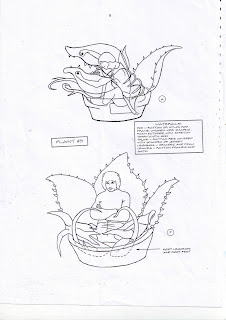Pre-Production
Risk | Solution |
Use of power tools | Wear safety equipment, such as masks, safe clothing, goggles and gloves. |
Cutting equipment | This includes not walking around with sharp tools, such as knives and always cutting away from the body. |
Use of paint and glue | Using water based liquids and cleaning up all spills. |
Lifting heavy equipment | Always work in groups and make sure to bend knees not backs. |
Making sure the action props were safe for the actors | Especially the plant, always checking on the actor ensuring he can breathe, making sure the parts attached to his body don’t dig into his body, also insisting he has plenty of water to drink as it is very hot in the plant. |
Production
Risk | Solution |
Stage blackout | Ensuring that none of the crew trip and fall, colliding- making sure the crew use torches, and making sure that all scenery positions are clearly marked out on the floor. |
Height hazard | In case of falling off the stage, make sure clear announcements are made to cast/crew, using the curtains, pulling them during blackouts. |
Moving scenery around | All crew members have specific rehearsed job roles, such as pulling curtains, using torches during blackouts. |
Crowd Control | Always control ticket sales, and make sure staffs are at the doors as people come in to see the production, always research the legal limits of the venue, and draw out seating plans. |
Suitable materials | Always checks out fire ret ardency rules for the particular venue, nothing that could harm actors, backstage crew or audience. |
Fire | Make clear announcements and signs, carrying out the usual fire precautions, fire extinguishers to be seen. |
Props being lost/ misused | Always keep props (weaponry) on specific tables, logged and under control of the prop manager. |
The reason why we had to carry out a risk assessment was to gain an insight on how we could help the production run more smoothly, as we wanted the production to be as professional as in the theatre, backstage and on stage too.
Firstly we researched possible risks that could be encountered in a real theatre production, and thought of our own, we started thinking of how we could solve the problems and make them more safer for us to work on and also for the actors/actresses.
Usually in the theatre, risks such as equipment, props being left out and blackouts are looked at very closely as they could be a threat to people working on the set and off.
Aspects like this have to be looked at very closely as there is no time for faults in the theatre, as everything has to be of a high standard and professional. Whilst working backstage of the production, I was in charge of holding two torches and putting them on when there were stage blackouts, to make sure that people were not colliding into each other and tripping up over wires that were used as props.
There was also someone in charge at the back of the stage to make sure the fire exit was clear at all times, making sure that in case there may have been a fire most of the backstage crew would have to exit from the back doors of the stage.
Researching and learning about the main risks encountered in the theatre has taught me that in order for something to work in the industry there has to be very strong communication between the cast and backstage helpers, and team work, as everything has to be perfect especially backstage for no faults to show on stage whilst performing, I feel that the backstage crew are very important in order to have a good show, as they are mostly in charge of making sure nothing goes wrong, and everything runs smoothly.

























